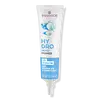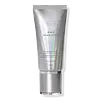What's inside
What's inside
 Key Ingredients
Key Ingredients

 Benefits
Benefits

 Concerns
Concerns

 Ingredients Side-by-side
Ingredients Side-by-side

Water
Skin ConditioningSilica
AbrasiveDicaprylyl Carbonate
EmollientCoco-Caprylate/Caprate
EmollientCetearyl Olivate
Glycerin
HumectantDimethicone
EmollientIsoamyl Laurate
EmollientNiacinamide
SmoothingPentylene Glycol
Skin ConditioningSorbitan Olivate
EmulsifyingXylitylglucoside
HumectantCucumis Sativus Juice
EmollientPanthenol
Skin ConditioningSodium Hyaluronate
HumectantAnhydroxylitol
HumectantPropylene Glycol
HumectantTocopheryl Acetate
AntioxidantXylitol
HumectantAllantoin
Skin ConditioningBetaine
HumectantCocos Nucifera Fruit Juice
EmollientEthylhexylglycerin
Skin ConditioningSodium Sulfite
PreservativeLactic Acid
BufferingSodium Hydroxide
BufferingPhosphoric Acid
BufferingCitric Acid
BufferingPhenoxyethanol
PreservativeSodium Benzoate
MaskingPotassium Sorbate
PreservativeParfum
MaskingWater, Silica, Dicaprylyl Carbonate, Coco-Caprylate/Caprate, Cetearyl Olivate, Glycerin, Dimethicone, Isoamyl Laurate, Niacinamide, Pentylene Glycol, Sorbitan Olivate, Xylitylglucoside, Cucumis Sativus Juice, Panthenol, Sodium Hyaluronate, Anhydroxylitol, Propylene Glycol, Tocopheryl Acetate, Xylitol, Allantoin, Betaine, Cocos Nucifera Fruit Juice, Ethylhexylglycerin, Sodium Sulfite, Lactic Acid, Sodium Hydroxide, Phosphoric Acid, Citric Acid, Phenoxyethanol, Sodium Benzoate, Potassium Sorbate, Parfum
Water
Skin ConditioningCeteareth-6 Olivate
EmulsifyingCoconut Alkanes
EmollientNeopentyl Glycol Dicaprylate/Dicaprate
EmollientHydrogenated Olive Oil
Skin ConditioningPropanediol
SolventSqualane
EmollientCocos Nucifera Water
MaskingCocos Nucifera Fruit Juice
EmollientLactobacillus
Skin ConditioningAloe Barbadensis Leaf Juice
Skin ConditioningCaffeine
Skin ConditioningGlycyrrhiza Uralensis Root Extract
Skin ConditioningCeramide AP
Skin ConditioningRetinol
Skin ConditioningLactic Acid
BufferingButyrospermum Parkii Butter
Skin ConditioningSodium Starch Octenylsuccinate
AbsorbentGlycerin
HumectantPolyacrylate Crosspolymer-6
Emulsion StabilisingCoco-Caprylate/Caprate
EmollientOlea Europaea Fruit Oil
MaskingTrisodium Ethylenediamine Disuccinate
Olea Europaea Oil Unsaponifiables
Skin ConditioningCaprylic/Capric Triglyceride
MaskingAnanas Sativus Fruit Extract
Skin ConditioningCoffea Arabica Leaf/Seed Extract
MaskingJasminum Officinale Flower/Leaf Extract
MaskingDipteryx Odorata Seed Extract
MaskingCocos Nucifera Fruit Extract
EmollientPrunus Armeniaca Fruit Extract
Skin ConditioningCucumis Melo Cantalupensis Fruit Extract
AstringentVanilla Planifolia Fruit Extract
Skin ConditioningCitrus Aurantium Dulcis Peel Extract
Emulsion StabilisingPhenoxyethanol
PreservativeHexylene Glycol
EmulsifyingCaprylyl Glycol
EmollientSodium Benzoate
MaskingPotassium Sorbate
PreservativeWater, Ceteareth-6 Olivate, Coconut Alkanes, Neopentyl Glycol Dicaprylate/Dicaprate, Hydrogenated Olive Oil, Propanediol, Squalane, Cocos Nucifera Water, Cocos Nucifera Fruit Juice, Lactobacillus, Aloe Barbadensis Leaf Juice, Caffeine, Glycyrrhiza Uralensis Root Extract, Ceramide AP, Retinol, Lactic Acid, Butyrospermum Parkii Butter, Sodium Starch Octenylsuccinate, Glycerin, Polyacrylate Crosspolymer-6, Coco-Caprylate/Caprate, Olea Europaea Fruit Oil, Trisodium Ethylenediamine Disuccinate, Olea Europaea Oil Unsaponifiables, Caprylic/Capric Triglyceride, Ananas Sativus Fruit Extract, Coffea Arabica Leaf/Seed Extract, Jasminum Officinale Flower/Leaf Extract, Dipteryx Odorata Seed Extract, Cocos Nucifera Fruit Extract, Prunus Armeniaca Fruit Extract, Cucumis Melo Cantalupensis Fruit Extract, Vanilla Planifolia Fruit Extract, Citrus Aurantium Dulcis Peel Extract, Phenoxyethanol, Hexylene Glycol, Caprylyl Glycol, Sodium Benzoate, Potassium Sorbate
Alternatives
Ingredients Explained
These ingredients are found in both products.
Ingredients higher up in an ingredient list are typically present in a larger amount.
Coco-Caprylate/Caprate is created from fatty coconut alcohol, caprylic acid, and capric acid.
It is a lightweight emollient. Emollients create a thin barrier on the skin to trap moisture in. This helps keep your skin hydrated and soft.
Once applied, Coco-Caprylate/Caprate is absorbed quickly and leaves a silky feel.
Coco-Caprylate/Caprate may not be fungal acne safe.
Learn more about Coco-Caprylate/CaprateWe don't have a description for Cocos Nucifera Fruit Juice yet.
Glycerin is already naturally found in your skin. It helps moisturize and protect your skin.
A study from 2016 found glycerin to be more effective as a humectant than AHAs and hyaluronic acid.
As a humectant, it helps the skin stay hydrated by pulling moisture to your skin. The low molecular weight of glycerin allows it to pull moisture into the deeper layers of your skin.
Hydrated skin improves your skin barrier; Your skin barrier helps protect against irritants and bacteria.
Glycerin has also been found to have antimicrobial and antiviral properties. Due to these properties, glycerin is often used in wound and burn treatments.
In cosmetics, glycerin is usually derived from plants such as soybean or palm. However, it can also be sourced from animals, such as tallow or animal fat.
This ingredient is organic, colorless, odorless, and non-toxic.
Glycerin is the name for this ingredient in American English. British English uses Glycerol/Glycerine.
Learn more about GlycerinLactic Acid is another well-loved alpha hydroxy acid (AHA). It is gentler than glycolic acid but still highly effective.
Its main role is to exfoliate the surface of the skin by loosening the “glue” that holds dead skin cells together. Shedding those old cells leads to smoother, softer, and more even-toned skin.
Because lactic acid molecules are larger than glycolic acid, they don’t penetrate as deeply. This means they’re less likely to sting or irritate, making it a great choice for beginners or those with sensitive skin.
Like glycolic acid, it can:
Lactic acid also acts as a humectant (like hyaluronic acid). It can draw water into the skin to improve hydration and also plays a role in the skin's natural moisturizing factor (NMF) in the form of sodium lactate.
Studies show it can boost ceramide production to strengthen the skin barrier and even help balance the skin’s microbiome.
To get results, choose products with a pH between 3-4.
Lower strengths (5-12%) focus on surface exfoliation; higher strengths (12% and up) can reach deeper in the dermis (deeper, supportive layer) to improve skin texture and firmness over time.
Though it was originally derived from milk, most modern lactic acid used in skincare is vegan. It is made through non-dairy fermentation to create a bio-identical and stable form suitable for all formulations.
When lactic acid shows up near the end of an ingredient list, it usually means the brand added just a tiny amount to adjust the product’s pH.
Legend has it that Cleopatra used to bathe in sour milk to help reduce wrinkles.
Lactic acid is truly a gentle multitasker: it exfoliates, hydrates, strengthens, and brightens. It's a great ingredient for giving your skin a smooth, glowing, and healthy look without the harshness of stronger acids.
Read more about some other popular AHA's here:
Learn more about Lactic AcidPhenoxyethanol is a preservative that has germicide, antimicrobial, and aromatic properties. Studies show that phenoxyethanol can prevent microbial growth. By itself, it has a scent that is similar to that of a rose.
It's often used in formulations along with Caprylyl Glycol to preserve the shelf life of products.
Potassium Sorbate is a preservative used to prevent yeast and mold in products. It is commonly found in both cosmetic and food products.
This ingredient comes from potassium salt derived from sorbic acid. Sorbic acid is a natural antibiotic and effective against fungus.
Both potassium sorbate and sorbic acid can be found in baked goods, cheeses, dried meats, dried fruit, ice cream, pickles, wine, yogurt, and more.
You'll often find this ingredient used with other preservatives.
Learn more about Potassium SorbateSodium Benzoate is a preservative. It's used in both cosmetic and food products to inhibit the growth of mold and bacteria. It is typically produced synthetically.
Both the US FDA and EU Health Committee have approved the use of sodium benzoate. In the US, levels of 0.1% (of the total product) are allowed.
Sodium benzoate works as a preservative by inhibiting the growth of bacteria inside of cells. It prevents the cell from fermenting a type of sugar using an enzyme called phosphofructokinase.
It is the salt of benzoic acid. Foods containing sodium benzoate include soda, salad dressings, condiments, fruit juices, wines, and snack foods.
Studies for using ascorbic acid and sodium benzoate in cosmetics are lacking, especially in skincare routines with multiple steps.
We always recommend speaking with a professional, such as a dermatologist, if you have any concerns.
Learn more about Sodium BenzoateWater. It's the most common cosmetic ingredient of all. You'll usually see it at the top of ingredient lists, meaning that it makes up the largest part of the product.
So why is it so popular? Water most often acts as a solvent - this means that it helps dissolve other ingredients into the formulation.
You'll also recognize water as that liquid we all need to stay alive. If you see this, drink a glass of water. Stay hydrated!
Learn more about Water